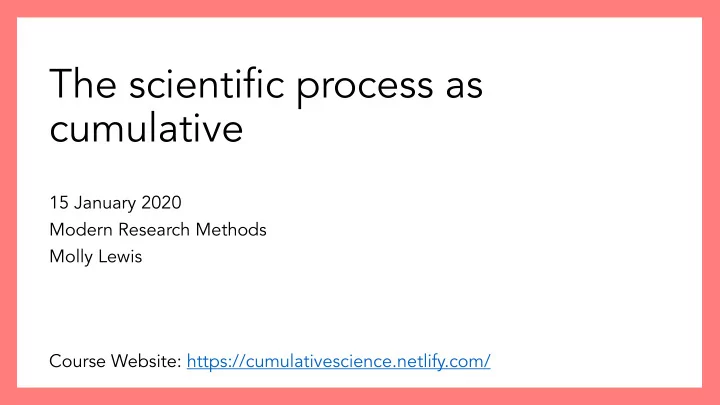

The scientific process as cumulative 15 January 2020 Modern Research Methods Molly Lewis Course Website: https://cumulativescience.netlify.com/
Business • Survey • https://tinyurl.com/MRM-survey • Jaeah’s office location: Psych. lounge • Qs about syllabus? https://cumulativescience.netlify.com/
Last Time: Cumulative Science The Scientific Process
Today: An introduction to cumulative science tools How do kids learn the meaning of new words? Graduate Student, Molly
There are infinite possibilities when a child hears a new word, how do they figure out the right one? But, it gets even harder… “dax”
Proposal in the literature How do kids learn the meaning of new words?
Let’s try it out If I’m picking examples from P (”dax” means dog) = medium P (”dax” means dalmation) = high P (”dax” means dalmation) = medium the dalmation category, I’m P (”dax” means dog) = low more likely to pick three dalmations If I’m picking examples from the dog category, it would be really unlikely to pick three dalmations It would be a “suspicious coincidence”! “dax” Xu and Xu d Te Tenenbaum (2 (2007)
The Size Principle In general, more exemplars (Subordinate) make the more specific (Basic) category more likely. (Superordinate) (Subordinate) (Basic) (Superordinate) Xu Xu and d Te Tenenbaum (2 (2007)
Testing the suspicious coincidence effect Each participant saw some “1 example” trials, and some “3 example” trials
Children and adults make this inference (e.g. dog) Generalize word more narrowly when get more examples! Xu Xu and d Te Tenenbaum (2 (2007)
A theory of how children could learn the meaning of new words at mu action . multiple levels of f ab abstrac NUMBER of examples of word meaning provides information “dax”
2007 2007 2011 2011
Your theory is wrong… “The striking finding that led Xu and Tenenbaum (2007b) to this conclusion— Your theory predicts that broader generalization from a single instance than from three (nearly identical) i nstances— is is it’s just NUMBER of al also consistent with mechan anistic ac accounts examples but other things couched in terms of memories and representations for learning events. […] In the might matter too. case of the suspicious-coincidence effect, two such task factors may be particularly critical: The fact that the exemplars ar are simultan aneously vi visi sible in the task space and that they are nearly identical instances in cl close se sp spati tial pr proximity. “ – Spencer, et al. (2011)
Sequential presentation of exemplars (Spencer, (Spencer, et al., 2011) et al., 2011) ...makes the effect reverse??
Resolving a conflict in the literature Did a replication of both studies. ?? I want to understand this discrepancy, and build on it LICATE = Repeat a study REPLI with the same population, hypothesis, experi mental design, and analysis 2018 2018 plan and get same result (Patil, et al. 2016)
Replicating previous results • Stimuli and code from original experiments weren’t available so I had to implement using Javascript and HTML (https://tinyurl.com/ry3tvyz) • Analyzed data in a programming language called R • Before I ran my study, I pre-registered experimental code/analysis plan (https://osf.io/wgvcw) - why? • Conducted a replication of these studies online using a large sample ( N = 600) of participants
Reproducibility RODUCE = Repeat procedure (e.g. experimental REP REPROD code, analysis code) and get same result • All my code is available online so that other researchers can re roduce my experiment and analysis repro • Website called Github (https://github.com/) • https://github.com/mllewis/XTMEM
What did I find? Replication of Replication of Spencer et al. (2011) Xu and Tenenbaum (2007) (Lewis & Frank, Psych. Science , 2018)
Trial order matters! • Only see the suspicious coincidence effect in the 1-3 ordering • How can we test this idea? • Meta-analysis – technique for quantifying size of an effect across studies. Bi Big effect Sl Slight htly s smaller er ef effec ect
simultaneous timing sequential timing 2 1 − 3 trial order 1 0 Cohen's d − 1 2 3 − 1 trial order 1 0 − 1 XT SPSS LF XT SPSS LF Paper
Expert Exp Ed Editor or Sub Submit t to a a journal al Exp Expert Peer Review Process Exp Expert
Tools I used in this project • Online experiments • Data analysis in R • Preregistration • Reproducible workflows (e.g. Github) • Meta-analysis • In this class, you will learn about all of these tools • You will not master any of them, but my goal is to introduce them to you so you can have the ability to learn more
Next Time: Introduction to R (Lab) • Bring your computer if you prefer to use it • Porter 332P • Reading:
Recommend
More recommend